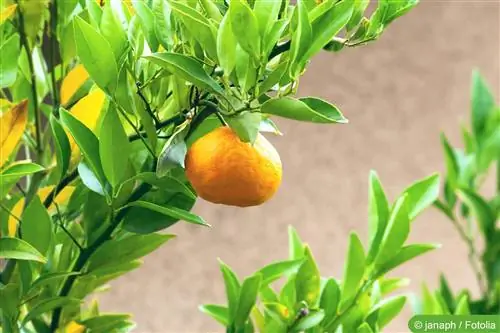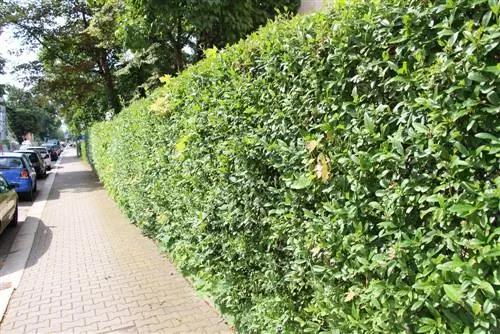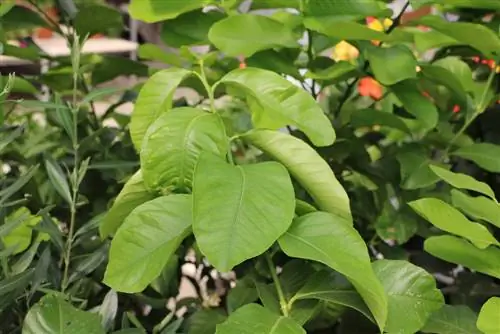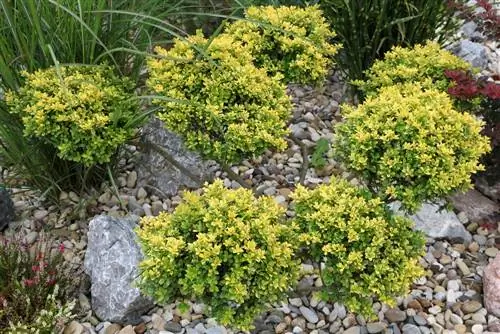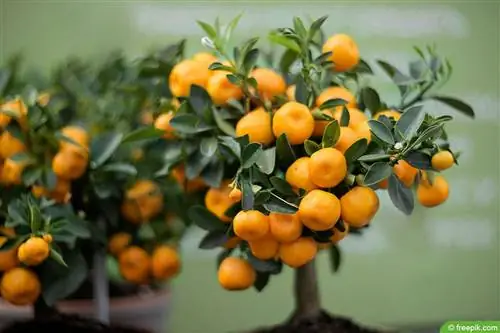- Author admin [email protected].
- Public 2024-01-15 11:54.
- Last modified 2025-06-01 06:48.
Tangerine trees originally come from warmer climes, but are also becoming increasingly popular in our latitudes as decorative pot plants. Before the first frost, put the fruit trees indoors. In winter, the citrus fruits should be kept bright but cool indoors. South-facing windows can be a problem because the sun burns hard behind glass. Sunburn may occur.
Location and substrate for tangerine trees
That's why an east or west window is a better location. If the tangerine tree only receives light from one direction, it should be rotated regularly. The best place to overwinter is a winter garden where temperatures are around 10 degrees Celsius. Special citrus plant soil is suitable as soil, but normal potting soil mixed with a little clay is also not bad. Citrus plants love loamy soil.
Proper care
Similar to a lemon tree, when watering, care should be taken to ensure that the plant does not receive too much or too little water. Waterlogging is not tolerated. This can be prevented with a drainage layer at the bottom of the pot. You should water so that water flows out of the pot. Wait until the soil has dried before watering again. But the bale must not dry out! Watering should not be done around midday. If the plant curls up its leaves, water immediately. It is important to use low-lime or, better yet, lime-free water. If there is too much lime, the leaves turn yellow.
- In winter there may be a few weeks between waterings.
- In summer, fertilize regularly, preferably every 14 days.
- There are special fertilizers for citrus plants on the market.
It takes a few years for a tangerine tree to bloom. This is normal, you don't have to worry about it. You should only prune a tangerine tree if you want to curb the growth, otherwise pruning is not necessary. If pruned, the tree will not bloom the next year.
Mandarin trees only need to be repotted when the pot has become too small. However, the new planter should not be much larger than the old one. To make the soil loose and airy, Styrofoam balls, expanded clay or perlite can be mixed in. After repotting, do not put the plant back in the sun immediately. The best time for repotting is spring.
Care errors
Incorrect care can mean that a tangerine tree does not thrive as well as you would like. Often you can still save the tree, but sometimes it is too late. Many of the citrus plants are simply drowned. Others have the wrong location, which is a crucial criterion, especially in winter. The important thing is to recognize that something is wrong. Then this can be fixed.
Rolled up leaves
- If almost all of the leaves curl up, the plant needs water. The best way to do this is to place the pot in a container of water until no more air bubbles appear.
- If the soil is moist and the leaves still curl up, it is too wet. The fine roots then die and the plant can no longer absorb water. Usually that's the end.
- Curled leaves on just one branch indicate that it is diseased. Water transport is no longer possible. It's best to cut it off.
Very soft and extremely long shoots
The mandarin tree rots, becomes sparse and loses its beautiful growth. This is usually due to the wrong location or too much heat and too much water. Cooling down helps here, watering significantly less and cutting back properly!
Yellow leaves
If no pests can be found, it is usually due to iron deficiency. The pH value must be checked here. If it is too high, the plant cannot absorb iron. Iron fertilizer (iron chelate) helps here. Do not use iron sulfate!
Bright to almost white leaves
There are probably missing nutrients here. This usually comes from too much water. The plant can no longer absorb nutrients due to broken roots. It's usually too late to save you. The damage is too massive.
Brownish or whitish spots
White or brownish spots on the leaves indicate sunburn. If the mandarin tree gets too much sun after overwintering indoors, it can cause burns. You have to slowly get used to the sun.
Pests on tangerine trees
Scale insects are often plant pests. These are best collected or scraped off. Spraying doesn't help because the animals are well protected with their thick shell. If chemical control, then the plant must be watered with the poison. The tree has to absorb the agent and passes it on to the pests when they eat it. This works, but many trees do not tolerate the individual remedies very well. Collecting is more laborious, but he althier for the plant.
Spider mites can be avoided by wiping the leaves with a damp cloth often. In the case of an infestation, only the chemical club usually helps. But spraying helps here.
Vermin often attack tangerine trees when they are in a draft, so drafts should be avoided at all costs.
Diseases in mandarin trees
Diseases are significantly less common than care errors and pests. However, they still occur from time to time. One of the most common is the
Sootdew - fungal disease. A blackish coating on the leaves indicates it. The fungus usually settles on the excretions of pests (honeydew). The leaves of the mandarin tree are relatively stable. You can try wiping carefully or you have to use chemicals!
There are some fungal diseases that affect citrus plants. Too much moisture in the root area is usually to blame. It is better if the tree has been grafted onto a very he althy base, as it is more resilient. Some fungi attack the roots, others attack leaves and branches. Fungicides can help.
- Bacteria can penetrate leaves, twigs and fruits through injuries. Bacteria are often spread by psyllids.
- In the worst case scenario, citrus canker occurs, which can be recognized by rounded, gray spots. Leaves and branches may die.
- Even viruses can occur, but only extremely rarely and more so in professional cultivation.
Conclusion of the editors
The mandarin tree is an extremely beautiful potted plant. Care is not as complicated as some might think. It's not necessarily a beginner's plant, but you don't have to be a professional either. It is important to purchase a suitable tree. Sometimes they are even offered in discount stores. It is not advisable to purchase such a standard tree. The documents are usually not good, the rearing was accelerated with aids. It's rare to enjoy a citrus plant like this for long. It is better to invest a few euros more and buy a tree from a specialist dealer. You can see the difference at first glance.

